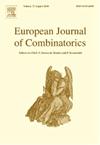The Frank number and nowhere-zero flows on graphs
IF 1
3区 数学
Q1 MATHEMATICS
引用次数: 0
Abstract
An edge of a graph is called deletable for some orientation if the restriction of to is a strong orientation. Inspired by a problem of Frank, in 2021 Hörsch and Szigeti proposed a new parameter for 3-edge-connected graphs, called the Frank number, which refines -edge-connectivity. The Frank number is defined as the minimum number of orientations of for which every edge of is deletable in at least one of them. They showed that every 3-edge-connected graph has Frank number at most 7 and that in case these graphs are also 5-edge-colourable the parameter is at most 3. Here we strengthen both results by showing that every 3-edge-connected graph has Frank number at most 4 and that every graph which is 3-edge-connected and 3-edge-colourable has Frank number 2. The latter also confirms a conjecture by Barát and Blázsik. Furthermore, we prove two sufficient conditions for cubic graphs to have Frank number 2 and use them in an algorithm to computationally show that the Petersen graph is the only cyclically 4-edge-connected cubic graph up to 36 vertices having Frank number greater than 2.
弗兰克数和零在图上流动
如果0对G−e的限制是强方向,则图G的边e对于某个方向o是可删除的。受Frank问题的启发,Hörsch和Szigeti在2021年提出了一个3边连通图的新参数,称为Frank数,它改进了k边连通性。Frank数定义为G的每条边至少在其中一条方向上可被删除的最小方向数。他们表明,每个3边连通图的Frank数最多为7,如果这些图也是5边可着色的,则参数最多为3。这里我们通过表明每个3边连通图的Frank数最多为4,以及每个3边连通和3边可着色的图的Frank数为2来加强这两个结果。后者也证实了Barát和Blázsik的猜想。进一步,我们证明了三次图Frank数为2的两个充分条件,并利用它们在一个算法中计算证明了Petersen图是唯一一个有36个顶点且Frank数大于2的循环四边连通的三次图。
本文章由计算机程序翻译,如有差异,请以英文原文为准。
求助全文
约1分钟内获得全文
求助全文
来源期刊
CiteScore
2.10
自引率
10.00%
发文量
124
审稿时长
4-8 weeks
期刊介绍:
The European Journal of Combinatorics is a high standard, international, bimonthly journal of pure mathematics, specializing in theories arising from combinatorial problems. The journal is primarily open to papers dealing with mathematical structures within combinatorics and/or establishing direct links between combinatorics and other branches of mathematics and the theories of computing. The journal includes full-length research papers on important topics.

 求助内容:
求助内容: 应助结果提醒方式:
应助结果提醒方式:


